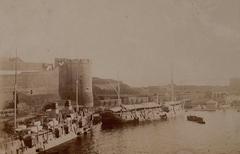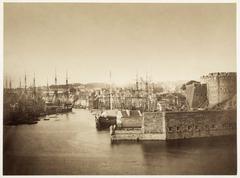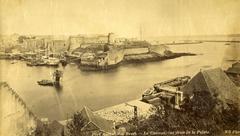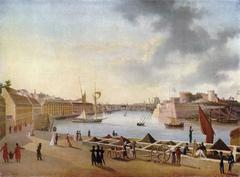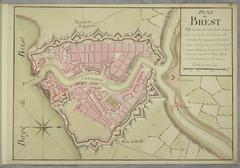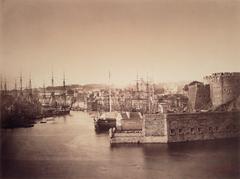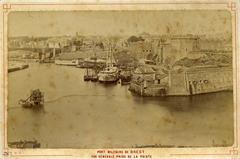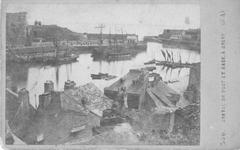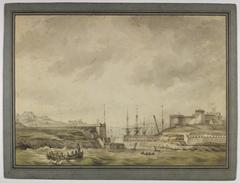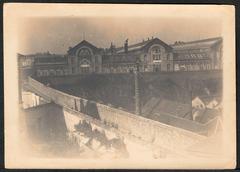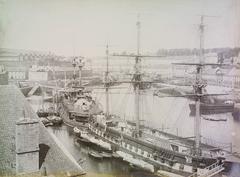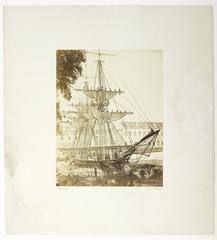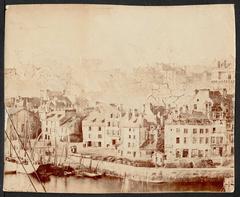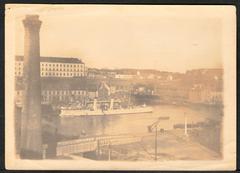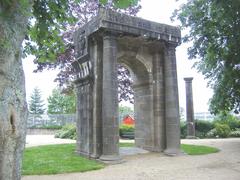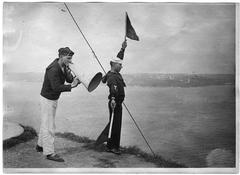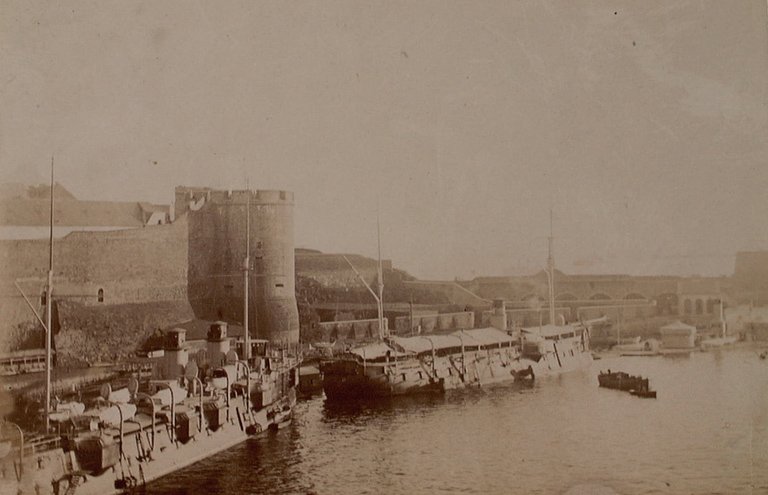
Batterie De La Rose: Visiting Hours, Tickets, and Complete Brest Historical Sites Guide
Date: 14/06/2025
Introduction
Perched on the windswept Pointe de la Rose, Batterie De La Rose is a powerful monument to Brest’s enduring maritime and military heritage. Part of a network of fortifications that have protected the entrance to the vital Rade de Brest since the 17th century, this site offers a fascinating journey through centuries of military strategy, engineering, and local resilience. Today, it stands as a testament to both the region’s strategic importance and its spirit of renewal, providing panoramic vistas of Brittany’s rugged coastline and insight into the legacy of France’s coastal defenses (France-Voyage; Tourisme Bretagne; Brest Terres Océanes).
This definitive guide covers Batterie De La Rose’s history, architecture, visiting hours, ticket policies, accessibility, nearby attractions, and practical tips to help you make the most of your visit to this must-see Brest historical site.
Table of Contents
- Introduction
- Historical Background & Strategic Importance
- Architectural Features & Wartime Role
- Postwar Legacy and Preservation
- Visiting Information: Hours, Tickets, and Accessibility
- Visitor Tips and Safety
- Nearby Attractions & Suggested Itineraries
- Frequently Asked Questions (FAQ)
- Conclusion & Further Resources
Historical Background & Strategic Importance
Origins and Evolution
Batterie De La Rose traces its origins to the era of Louis XIV, when master engineer Vauban and his successors fortified Brest’s approaches against maritime threats. Commanding a sweeping view over the Rade de Brest—one of Europe’s largest natural harbors—the battery’s placement was pivotal for monitoring and defending the port, a cornerstone of French naval power for centuries.
Over the years, the battery was continuously updated to reflect advancements in artillery and shifting strategies, serving alongside fortresses like Château de Brest and Tour Tanguy as part of an interconnected defensive network (Tourisme Bretagne).
World War II and the Atlantic Wall
During World War II, Batterie De La Rose was integrated into the German Atlantic Wall, a vast coastal defense system stretching from Norway to Spain. Reinforced with new bunkers and heavy artillery, it played a critical role in defending the harbor and submarine pens during the fierce fighting of the 1944 Battle for Brest (Wikipedia: Brest, France).
Architectural Features & Wartime Role
Key Structures
- Gun Emplacements: Reinforced concrete or stone positions for large-caliber coastal guns, arranged to create overlapping fields of fire.
- Ammunition Magazines: Subterranean or semi-buried spaces for safe storage of shells and powder.
- Observation Posts: Bunkers and lookout points offering commanding views for targeting and coordination.
- Personnel Shelters: Bomb-proof shelters built into the terrain for the garrison’s protection.
Defensive Innovations
Batterie De La Rose’s design reflects the evolution from traditional masonry to reinforced concrete, maximizing both survivability and concealment within the landscape. Its integration with neighboring batteries and communication posts allowed coordinated defense of the harbor approaches (Mapcarta).
Postwar Legacy and Preservation
Following WWII, fixed coastal fortifications like Batterie De La Rose became obsolete due to advances in military technology. While some sections fell into disrepair, local advocacy and municipal oversight have helped preserve the site. Community efforts focus on cleaning, vegetation control, and the addition of interpretive signage, ensuring that visitors can safely explore the remaining structures and learn about their significance (Carnet des Capades).
Visiting Information: Hours, Tickets, and Accessibility
Location & Access
- Address: Pointe de la Rose, Roscanvel Peninsula, near Brest, France
- Distance from Brest: Approximately 15 km; best reached by car via D355/D355A or by guided tour. Public transportation is limited.
Visiting Hours and Tickets
- Hours: Open-access, year-round, generally from sunrise to sunset. There are no official closing times; daylight hours are recommended for safety.
- Tickets: Entry is free. No reservation or ticket purchase required.
Accessibility
- Terrain: Uneven, with steep and natural paths; sturdy footwear is essential.
- Mobility: Not fully accessible due to natural obstacles. Those with mobility issues should contact local tourism offices for advice.
- Facilities: No restrooms or cafés on-site; amenities are in Roscanvel or Brest (navaway.fr).
Guided Tours
Guided visits may be available during peak tourist season or by arrangement with local historical associations or the Brest Métropole Tourisme office. These offer deeper historical context and stories from the site’s past.
Visitor Tips and Safety
- Wear comfortable, sturdy shoes.
- Bring water and snacks, especially for longer visits.
- Be prepared for variable weather—windproof jackets and umbrellas are recommended.
- Supervise children closely; avoid climbing on fragile structures.
- Stay on marked paths to protect both yourself and the site.
- Take all litter with you; respect the landscape and wildlife.
- Photography is encouraged; check drone regulations if applicable.
Nearby Attractions & Suggested Itineraries
Make the most of your trip by combining Batterie De La Rose with other Brest historical sites:
- Pointe des Espagnols: Another dramatic fortification with panoramic views.
- Château de Brest: Home to the National Maritime Museum, showcasing the city’s naval history.
- Tour Tanguy: Medieval tower with historical exhibits and city views.
- Océanopolis: A leading French aquarium, great for families.
- Recouvrance District: Explore historic neighborhoods, Breton markets, and local cuisine.
- Les Ateliers des Capucins: Cultural center with exhibitions and panoramic terraces (Brest Terres Océanes).
For walking enthusiasts, the Route des Phares offers scenic coastal paths dotted with lighthouses and historic batteries (Tourisme Bretagne).
Frequently Asked Questions (FAQ)
Q: What are the Batterie De La Rose visiting hours?
A: Open-access, year-round during daylight hours (sunrise to sunset).
Q: Is there an entrance fee or tickets required?
A: No, the site is free to access.
Q: Are guided tours available?
A: Occasionally in summer or by arrangement with local tourism offices.
Q: Is the site wheelchair accessible?
A: Due to uneven terrain and steps, accessibility is limited.
Q: Are there facilities on-site?
A: No restrooms or cafés; amenities are in nearby villages.
Q: Is photography allowed?
A: Yes, photography is encouraged. Check local drone regulations before flying.
Q: What is the best time to visit?
A: Late spring and early autumn offer mild weather and fewer crowds.
Conclusion & Further Resources
Batterie De La Rose is an evocative window into Brest’s layered military past. Its commanding views, well-preserved structures, and open-access policy make it an ideal destination for history lovers, families, and photographers alike. By exploring this site, you support ongoing preservation efforts and help keep alive the memory of Brest’s coastal defense heritage.
For the latest updates on events, guided tours, and visiting conditions, consult official tourism resources and consider downloading the Audiala app for in-depth guides and audio tours.
References and Useful Links
- France-Voyage: Brest Tourism
- Tourisme Bretagne: La Route des Phares
- Brest Terres Océanes: Events & Attractions 2025
- Mapcarta: Batterie De La Rose
- Carnet des Capades: Visite Brest
- Wikipedia: Brest, France
- navaway.fr: Visiter Brest
- generationvoyage.fr: Que faire à Brest
- placesandthingstodo.com: Brest Sightseeings
- asherfergusson.com: France Packing List
- lonelyplanet.com: France Travel Tips
Images and interactive maps are available in the online version, with alt tags such as “Batterie De La Rose overlooking Brest harbor” and “Gun emplacement at Batterie De La Rose.”
